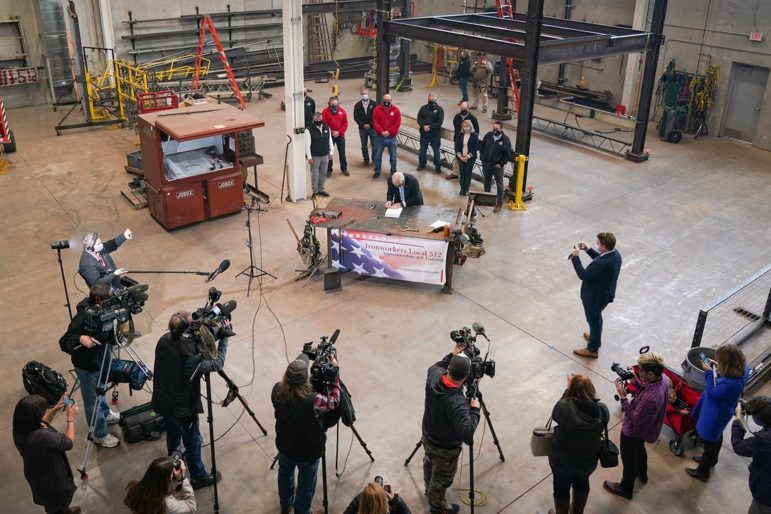
This has been a year like no other in Minnesota politics. Since the 2020 legislative session ended in May, legislators have continued to convene once a month in special session to debate Minnesota’s COVID-19 response and Governor Walz’s use of emergency powers. Along the way, legislators have continued to debate items that were left unfinished at the end of the 2020 regular session.
The highest profile piece of unfinished business before the Legislature has been the Capital Investment/public works bill, commonly referred to as the “bonding bill.” Finally, during the fifth special session of 2020 in early October, legislators secured a bipartisan deal to pass the 2020 bonding bill. Fresh Energy had four key recommendations for special session, one of which was prioritizing bonding investments in transit and affordable housing. We’re pleased to see that the bonding bill that was passed and signed into law by Governor Walz on October 21, 2020, included these pieces.
Here are a few of the highlights:
$55 Million for Bus Rapid Transit (BRT)
After years of badly under-investing in public transit, this year’s bonding bill finally includes meaningful investments in the next critical phase of bus rapid transit development. This appropriation will fully fund Metro Transit’s B and D lines – both of which are high demand routes that also serve neighborhoods disproportionately impacted by both COVID-19 and unrest following the killing of George Floyd. The B Line will run along Lake Street and Marshall Avenue, connecting Minneapolis to Saint Paul’s Union Depot. The D Line runs from Brooklyn Center through downtown Minneapolis to the Mall of America transit station. Finally, this appropriation will also support preliminary engineering work on the E Line, which will eventually run from the University of Minnesota campus to Southdale in Edina.
$116 Million for Affordable Housing
Minnesota’s affordable housing crisis has been well documented in recent years, but – as with transit – consistently under-supported with public dollars. The inclusion of $116 million for housing in the bonding bill is a good start, with much more needed in coming years. Investing in solutions that help address homelessness and housing insecurity is a critical step toward confronting the economic and racial disparities that are so pervasive across Minnesota, and will help to empower Minnesotans that are among the most directly affected by the impacts of climate change. Importantly, access to quality affordable housing has significant climate benefits.
$2 Million for Electric Vehicle Charging
Electric vehicles are continuing to grow in popularity and auto makers continue to signal their commitments to expanding their electric vehicle fleets. As electric vehicle options expand, public agencies can reduce emissions and save taxpayer dollars by converting to clean, electric vehicle fleets. This appropriation to the Minnesota Department of Administration will support new charging infrastructure at state-owned facilities throughout Minnesota.
SB2030 Building Standard
In addition to the appropriations above, it’s worth recognizing the inherent climate value of any bonding project. State law requires all projects that receive bonding dollars to be built to SB2030 standards. Developed at the University of Minnesota, SB2030 is a set of building performance standards that result in new buildings that are significantly more energy efficient – 70 percent more efficient than an average building for new construction between 2015-2020. In other words, every single building projects supported with bonding dollars – from gut renovations at the University of Minnesota to new civic centers in Greater Minnesota – is an above -average efficient building. When you consider that most buildings are intended to last for 50 years or longer, that’s a huge impact on carbon emissions and makes public buildings significantly cheaper to operate – another win for Minnesota taxpayers!
Looking Ahead
While the 2020 bonding bill makes a number of worthwhile investments and lays the groundwork for more to come, there is simply a lot more that needs to be done. The bonding bill is among the state’s most powerful tools for achieving both climate and equity outcomes, and those goals should be at the center of future bonding bills starting right away in 2021. In particular, Fresh Energy strongly believes that future bonding proposals should:
- Significantly accelerate the buildout of public transitways, both in the Twin Cities and in communities across Minnesota. Transportation is now the leading source of carbon pollution in Minnesota, and clean, electric transit options will be the foundation upon which we confront this significant challenge – while also reducing the inequitable access to employment and basic services faced by many under-resourced and Black, Indigenous, and people of color (BIPOC) communities in Minnesota.
- Systematically leverage the state’s purchasing power to drive climate solutions; opportunity abounds both when the state makes decisions about how to source and procure materials for infrastructure projects as well as during project design. Retrofitting an existing building? That’s a great time to install electric vehicle charging stations. Building a new bridge? Let’s source that steel as locally as possible to reduce emissions.
- Continue to prioritize housing affordability, with even larger future infusions of bonding dollars along with design choices that improve the health and affordability of housing. There’s no reason that public and/or affordable housing investments can’t leverage the immense resources that already exist in Minnesota to incorporate extremely efficient building design that minimize or eliminate fossil fuel dependence – improving indoor air quality and health, and reducing the burden of utility bills.
Fresh Energy is your clean energy, clean recovery, and clean jobs champion at the State Capitol and is committed to partnering with stakeholders and public officials to ensure that climate and equity are at the center of future bonding bill negotiations. Investing in public infrastructure is among the most powerful tools at our disposal for driving equitable carbon reduction, and it is critical that we maximize every opportunity.
